Table of Contents
Is there anything more comforting than a bowl of homemade chicken noodle soup? Especially when you start with a whole chicken, infusing every spoonful with rich, unforgettable flavor. This isn't just soup; it's a hug in a bowl, a remedy for whatever ails you, and a delicious way to use a single chicken for multiple meals. Forget the canned stuff – we're diving headfirst into creating the ultimate chicken noodle soup recipe from whole chicken, from simmering the perfect broth to adding the freshest ingredients. We’ll walk you through each step, sharing secrets for a clear, flavorful broth and tender, juicy chicken.
Why Make Chicken Noodle Soup with a Whole Chicken?
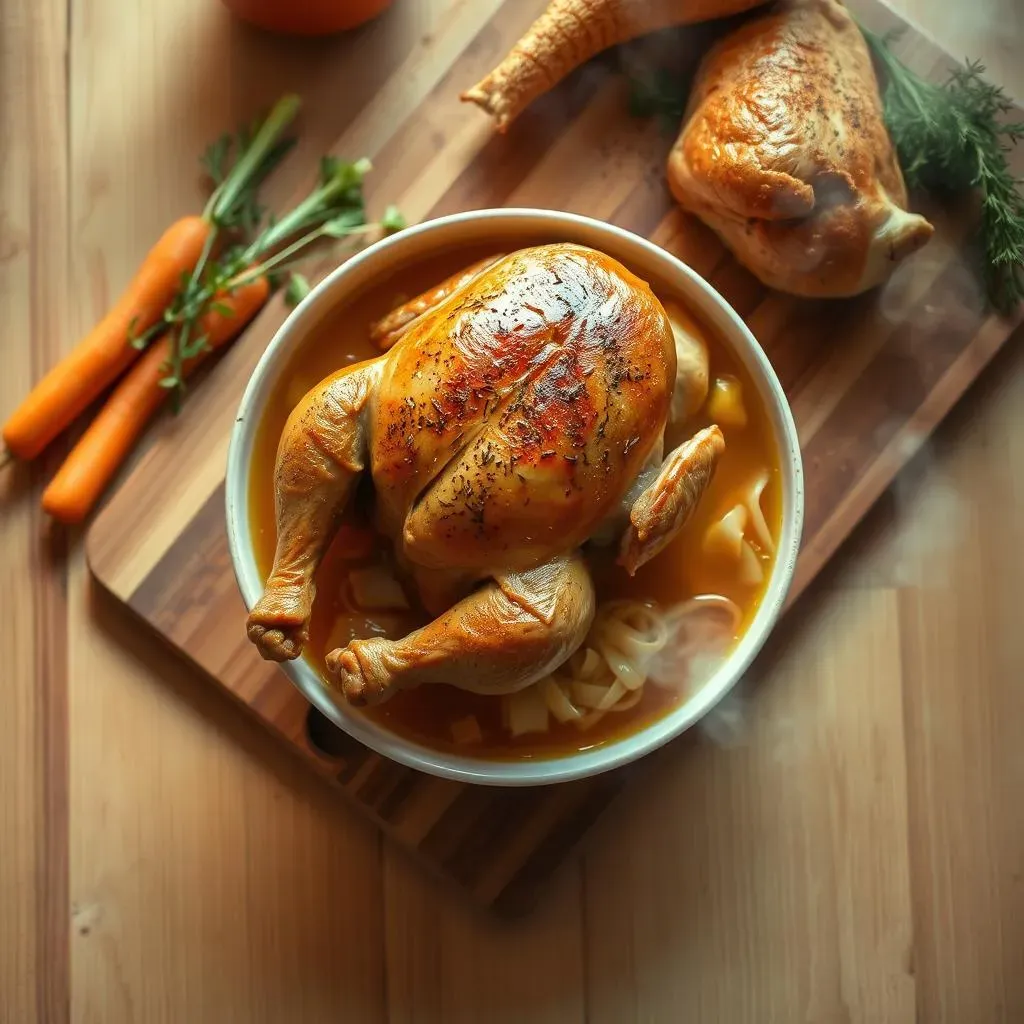
Why Make Chicken Noodle Soup with a Whole Chicken?
so you might be thinking, "Whole chicken? Isn't that a bit much for soup?" Trust me, it's not. It's a game changer. Using a whole chicken is the secret ingredient to unlocking a depth of flavor you simply can't achieve with pre-cut pieces or broth from a box. When you simmer that bird, the meat slowly releases its juices, creating a broth that's rich, complex, and utterly delicious. Plus, you get tender, shredded chicken to add back into the soup – no dry, flavorless bits here!
Think about it: bones, skin, and all those little bits contribute collagen, which enriches the broth, giving it a silky, luxurious texture. It's like making your own liquid gold. And let's not forget the satisfaction of knowing exactly what's going into your soup – no mystery ingredients or hidden sodium. You're in control, crafting a nourishing and wholesome meal from scratch. You are not only making soup, you are making memories.
Beyond flavor, using a whole chicken is economical. You're essentially getting two meals in one: a flavorful broth and plenty of cooked chicken that can be used in salads, sandwiches, or even tacos the next day. It's a sustainable and resourceful way to cook, minimizing waste and maximizing flavor. So, ditch the shortcuts and embrace the whole chicken – your taste buds (and your wallet) will thank you.
StepbyStep: Crafting Your Chicken Noodle Soup Recipe from Whole Chicken
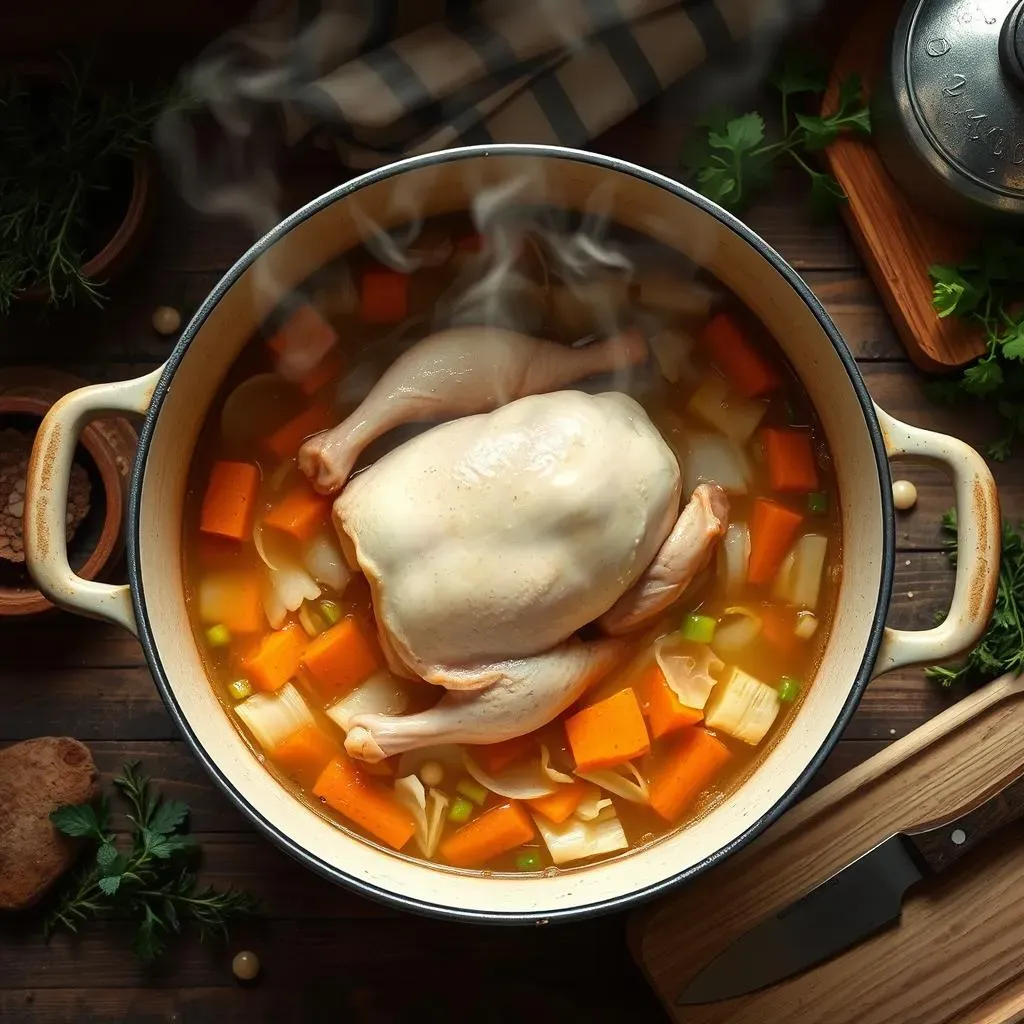
StepbyStep: Crafting Your Chicken Noodle Soup Recipe from Whole Chicken
#1: Prep Your Ingredients and the Chicken
Alright, let's get down to business! First things first, gather your ingredients. You'll need a whole chicken (about 3-4 pounds is perfect), carrots, celery, onion, garlic, egg noodles (or your favorite pasta), fresh herbs (like thyme, rosemary, and parsley), salt, pepper, and chicken broth or water. Now, give that chicken a good rinse, inside and out. Remove any giblets or excess fat you find lurking inside the cavity. Don't worry about being too perfect – we're going for rustic charm here!
Next, give your veggies a rough chop. No need for fancy knife skills – just get them into bite-sized pieces. I usually go for about 1-inch chunks. Mince your garlic, and if you're using fresh herbs, give them a chop as well. Having everything prepped and ready to go will make the cooking process a breeze. Trust me, future you will thank you!
#2: Simmering the Chicken for Maximum Flavor
Now for the magic to happen! Place the whole chicken in a large stockpot or Dutch oven. Add the chopped carrots, celery, onion, and garlic. Pour in enough chicken broth or water to completely cover the chicken – usually around 8-10 cups. Season generously with salt, pepper, and your favorite herbs. Bring the mixture to a boil over high heat, then immediately reduce the heat to low and simmer gently. This is crucial – you want a gentle simmer, not a rolling boil. Simmering allows the flavors to meld and the chicken to become incredibly tender without toughening up.
Skim off any foam or scum that rises to the surface during the first 30 minutes of simmering. This will help to create a clearer broth. Cover the pot and continue to simmer for 1.5 to 2 hours, or until the chicken is cooked through and the meat is falling off the bone. The exact time will depend on the size of your chicken, so check for doneness by piercing the thickest part of the thigh with a fork. If the juices run clear, you're good to go!
Here's a tip: For an even richer flavor, you can roast the chicken in the oven before simmering it in the soup. Simply rub the chicken with olive oil, salt, pepper, and herbs, and roast at 400°F (200°C) for about an hour, or until cooked through. Then, transfer the roasted chicken to the stockpot and proceed with the simmering instructions.
#3: Shredding the Chicken and Building the Soup
Carefully remove the chicken from the stockpot and set it aside to cool slightly. Once it's cool enough to handle, shred the meat from the bones, discarding the skin and bones. Don't worry about being too meticulous – some small pieces of bone are fine. Strain the broth through a fine-mesh sieve to remove any solids, leaving you with a clear, flavorful liquid. Return the strained broth to the stockpot and bring it to a boil over medium heat. Add the egg noodles (or your preferred pasta) and cook according to package directions until tender.
Once the noodles are cooked, add the shredded chicken back to the pot and stir to combine. Taste and adjust the seasoning as needed – you may want to add more salt, pepper, or herbs to suit your taste. Simmer for a few more minutes to allow the flavors to meld. Garnish with fresh parsley or dill, if desired. Serve hot and enjoy!
Perfecting the Broth: Simmering Secrets for the Best Chicken Noodle Soup
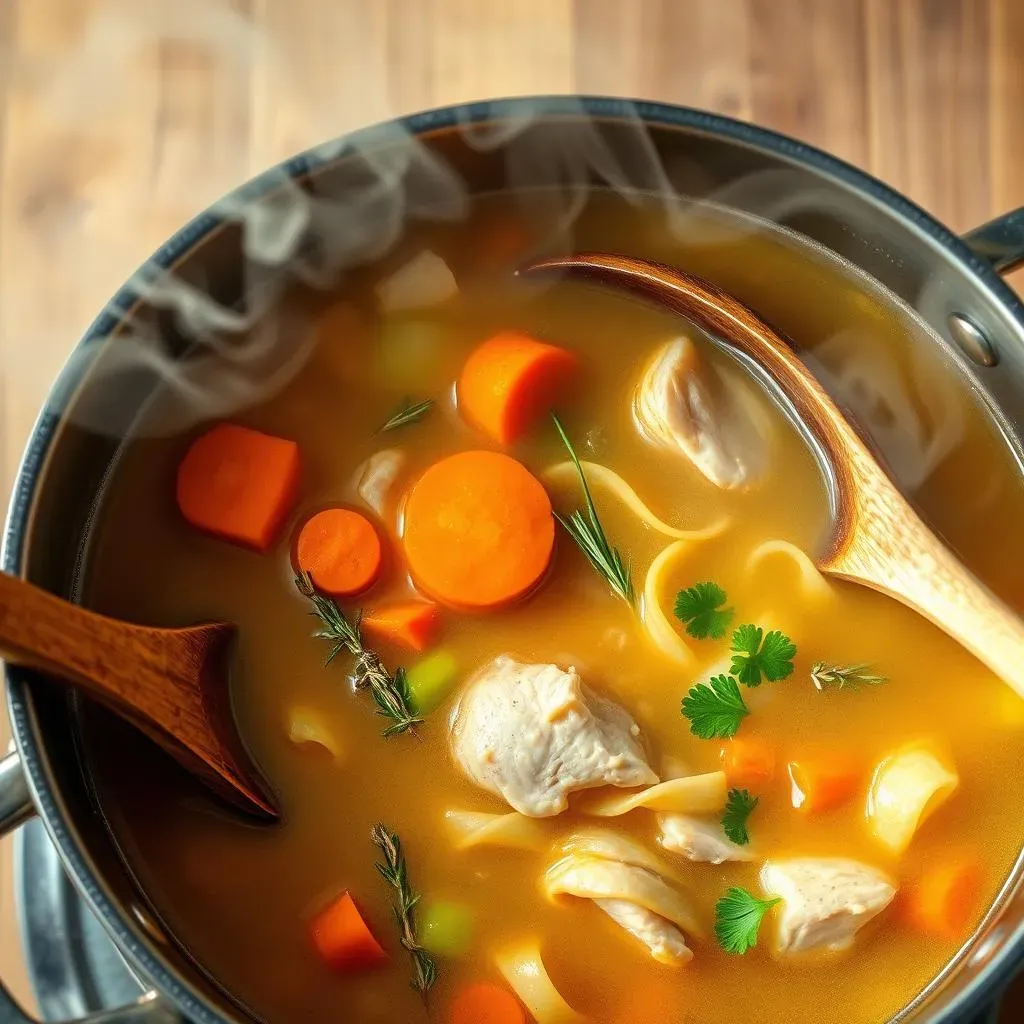
Perfecting the Broth: Simmering Secrets for the Best Chicken Noodle Soup
let's talk broth – the soul of any good chicken noodle soup. Perfecting the broth is where the magic truly happens. The key is patience and a few simple techniques. Remember that gentle simmer we talked about? That's non-negotiable. A rolling boil will cloud your broth and toughen the chicken. Think of it like a spa day for your chicken and veggies – low and slow is the name of the game.
But it's not just about the simmer. It's also about what you add to the pot. Don't be shy with the aromatics! Carrots, celery, and onion are the holy trinity, but feel free to experiment with other veggies like leeks, parsnips, or even a knob of ginger for a little zing. And herbs? Absolutely! Thyme, rosemary, parsley, bay leaf – they all add depth and complexity. Just remember to add them towards the end of simmering so their flavors don't get lost in the shuffle.
Another secret weapon? Chicken feet! I know, it sounds a little weird, but trust me on this one. Adding a few chicken feet to the pot will boost the collagen content of your broth, making it even richer and more gelatinous. You can usually find them at your local butcher or Asian market. And don't forget about salt! Salt is essential for drawing out the flavors of the chicken and veggies. Start with a generous amount and adjust to taste as you go.
And one last thing – don't be afraid to skim! As the broth simmers, foam and impurities will rise to the surface. Use a fine-mesh skimmer to remove them regularly. This will help to create a clearer, cleaner-tasting broth. Trust me, your taste buds will thank you.
Broth-Boosting Tip | Description |
|---|---|
Gentle Simmer | Avoid a rolling boil to keep the broth clear and the chicken tender. |
Aromatics are Key | Use carrots, celery, onion, and garlic generously. |
Herb Power | Add thyme, rosemary, parsley, and bay leaf for depth. |
Chicken Feet (Optional) | Boost collagen for a richer, more gelatinous broth. |
Salt Generously | Draws out the flavors of the chicken and veggies. |
Skim Regularly | Remove foam and impurities for a clearer broth. |
Customizing Your Chicken Noodle Soup Recipe: Veggies, Noodles, and More
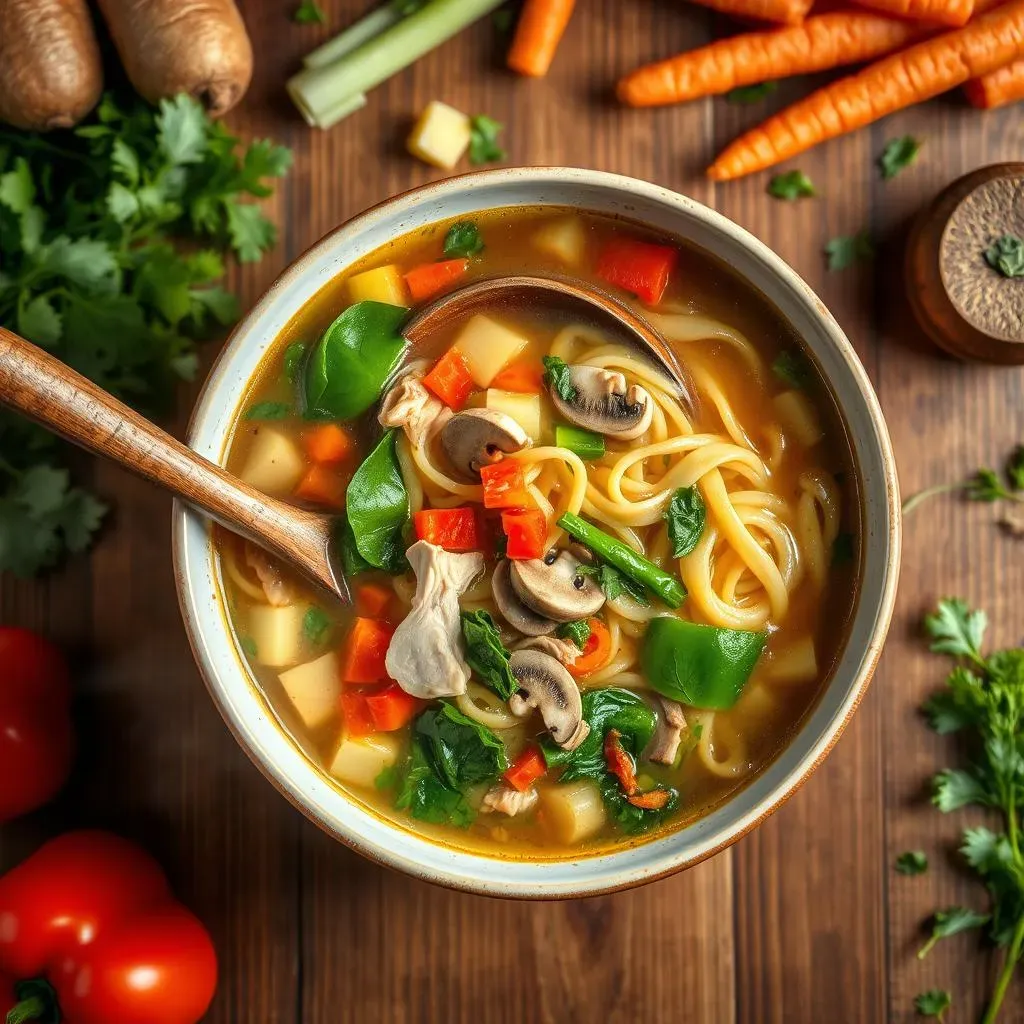
Customizing Your Chicken Noodle Soup Recipe: Veggies, Noodles, and More
#1: Veggie Variations: Beyond the Basics
so you've got the basic chicken noodle soup down. Now, let's get creative! This is where you can really let your personality shine. Think of your soup as a blank canvas and those veggies as your paint. Want a more vibrant soup? Add some diced bell peppers or spinach for a pop of color and nutrients. Craving something with a little more bite? Throw in some sliced mushrooms or zucchini. The possibilities are endless!
Don't be afraid to experiment with different textures, either. Roasted sweet potatoes or butternut squash can add a creamy sweetness, while chopped kale or collard greens bring a slightly bitter, earthy flavor. And if you're feeling adventurous, why not add some frozen peas or corn for a burst of summery goodness? Just remember to add any delicate veggies towards the end of cooking so they don't get mushy.
Veggie Addition | Flavor Profile | Best Time to Add |
|---|---|---|
Bell Peppers | Sweet, slightly tangy | With the carrots, celery, and onion |
Spinach | Mild, earthy | Last 5 minutes of cooking |
Mushrooms | Earthy, savory | With the carrots, celery, and onion |
Zucchini | Mild, slightly sweet | With the carrots, celery, and onion |
Sweet Potatoes/Butternut Squash | Sweet, creamy | With the carrots, celery, and onion |
Kale/Collard Greens | Bitter, earthy | Last 15 minutes of cooking |
Peas/Corn (Frozen) | Sweet, fresh | Last 5 minutes of cooking |
#2: Noodle Nirvana: Choosing Your Perfect Pasta
The noodles are another key component of chicken noodle soup, and there are so many options to choose from! Classic egg noodles are always a good choice – they're tender, slightly chewy, and soak up all that delicious broth. But don't feel limited to just egg noodles! Ditalini, orzo, and acini di pepe are all great options for a smaller, more delicate soup. And if you're looking for something a little heartier, try using rotini, farfalle, or even penne.
For a gluten-free option, you can use rice noodles, quinoa pasta, or even spiralized zucchini. Just be mindful of the cooking time, as some gluten-free pastas can become mushy if overcooked. And if you're feeling really ambitious, you can even make your own homemade pasta! It's a labor of love, but the results are well worth it. No matter what type of noodle you choose, make sure to cook it al dente – you want it to have a little bit of bite.
Storing and Reheating: Keeping Your Homemade Chicken Noodle Soup Fresh
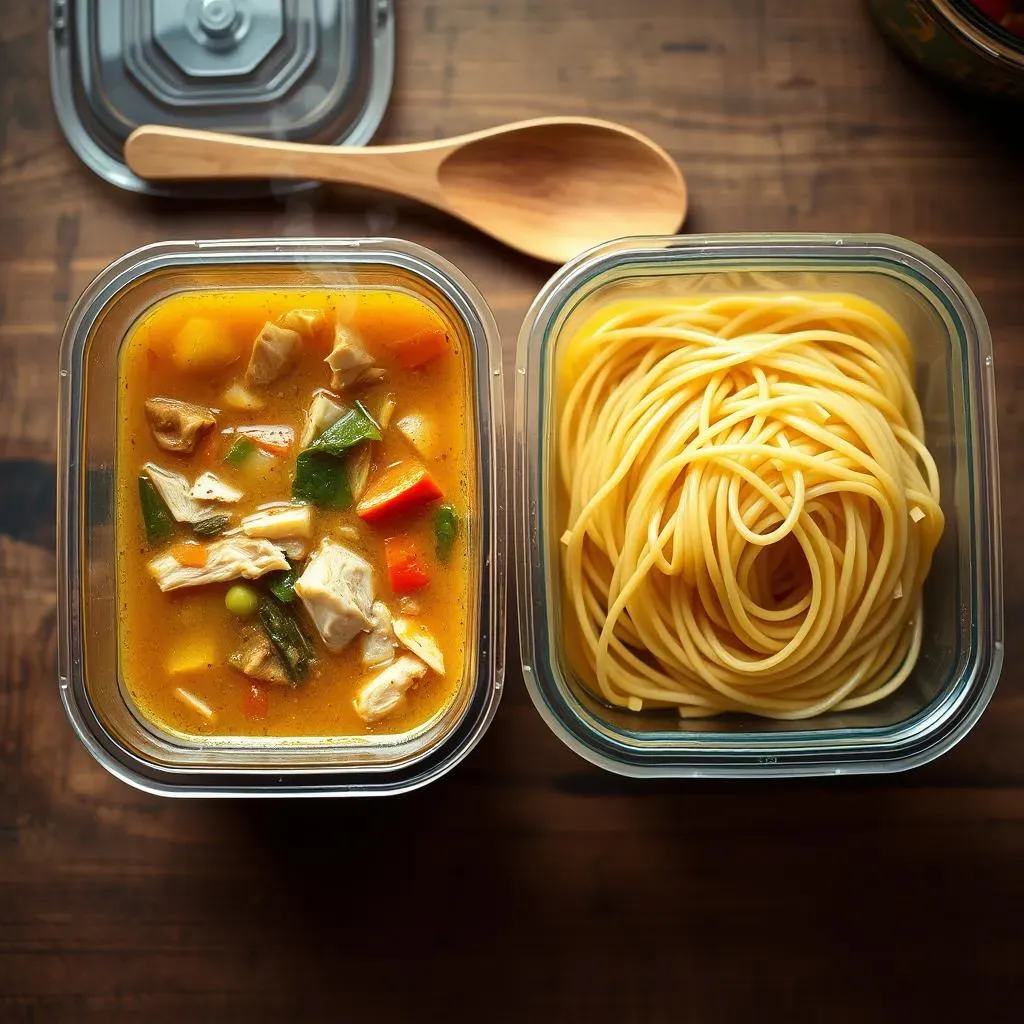
Storing and Reheating: Keeping Your Homemade Chicken Noodle Soup Fresh
#1: The Art of Storing: Separating for Success
Alright, you've made a big batch of this liquid gold, but what do you do with the leftovers? The key to maintaining that fresh-from-the-pot flavor is proper storage. And here's a pro tip: store the soup and noodles separately! I know, it sounds a little extra, but trust me, it makes a world of difference. If you store the noodles in the soup, they'll continue to absorb the broth and become mushy and bloated. Nobody wants mushy noodles!
Instead, let the soup cool completely, then transfer it to an airtight container. Store the cooked noodles separately in another container. This will prevent them from becoming overcooked and ensure they retain their perfect al dente texture. When you're ready to reheat, simply add the desired amount of noodles to the soup and heat until warmed through. It's like building your own fresh bowl of soup every time!
#2: Reheating Right: Bringing Back the Broth
So, you've got your perfectly stored soup and noodles, now it's time to reheat! The best way to reheat chicken noodle soup is on the stovetop over medium heat. Gently stir the soup occasionally to prevent sticking and ensure even heating. Avoid boiling the soup, as this can cause the noodles to become overcooked and the broth to lose some of its flavor. If the soup is too thick, you can add a little chicken broth or water to thin it out.
If you're short on time, you can also reheat the soup in the microwave. Just be sure to use a microwave-safe container and heat in short intervals, stirring in between, to prevent hot spots. And remember, the microwave can sometimes make the noodles a little chewier, so keep a close eye on them. Whether you choose the stovetop or the microwave, the goal is to gently warm the soup without compromising its flavor or texture.
Reheating Method | Pros | Cons |
|---|---|---|
Stovetop | Even heating, best flavor and texture | Takes longer |
Microwave | Quick and convenient | Can result in uneven heating and chewier noodles |
The Last Word on Homemade Chicken Noodle Soup
So there you have it – a complete guide to crafting a truly exceptional chicken noodle soup, all starting with one humble whole chicken. From the rich, golden broth to the perfectly cooked noodles and tender chicken, every element comes together to create a dish that's both comforting and deeply satisfying. Don't be afraid to experiment with your favorite vegetables and herbs to make it your own signature recipe. And remember, a batch of homemade chicken noodle soup is more than just a meal; it's an act of love, perfect for sharing with family and friends, or simply savoring on a cozy night in.
